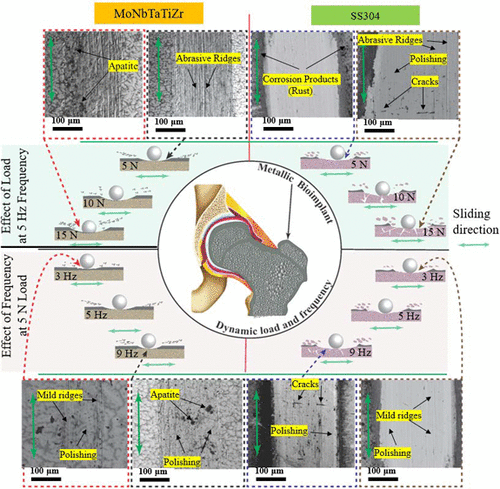当前位置:
X-MOL 学术
›
ACS Appl. Bio Mater.
›
论文详情
Our official English website, www.x-mol.net, welcomes your feedback! (Note: you will need to create a separate account there.)
Biocompatible High Entropy Alloys with Excellent Degradation Resistance in a Simulated Physiological Environment
ACS Applied Bio Materials ( IF 4.7 ) Pub Date : 2020-11-18 , DOI: 10.1021/acsabm.0c01181 Jibril Shittu 1 , Mayur Pole 1 , Irsalan Cockerill 1 , Maryam Sadeghilaridjani 1 , L Vinod Kumar Reddy 2 , Geetha Manivasagam 2 , Harpreet Singh 3 , Harpreet S Grewal 4 , Harpreet Singh Arora 4 , Sundeep Mukherjee 1
ACS Applied Bio Materials ( IF 4.7 ) Pub Date : 2020-11-18 , DOI: 10.1021/acsabm.0c01181 Jibril Shittu 1 , Mayur Pole 1 , Irsalan Cockerill 1 , Maryam Sadeghilaridjani 1 , L Vinod Kumar Reddy 2 , Geetha Manivasagam 2 , Harpreet Singh 3 , Harpreet S Grewal 4 , Harpreet Singh Arora 4 , Sundeep Mukherjee 1
Affiliation

|
Bioimplants are susceptible to simultaneous wear and corrosion degradation in the aggressive physiological environment. High entropy alloys with equimolar proportion of constituent elements represent a unique alloy design strategy for developing bioimplants due to their attractive mechanical properties, superior wear, and corrosion resistance. In this study, the tribo-corrosion behavior of an equiatomic MoNbTaTiZr high entropy alloy consisting of all biocompatible elements was evaluated and compared with 304 stainless steel as a benchmark. The high entropy alloy showed a low wear rate and a friction coefficient as well as quick and stable passivation in simulated body fluid. An increase from room temperature to body temperature showed excellent temperature assisted passivity and nobler surface layer of the high entropy alloy, resulting in four times better wear resistance compared to stainless steel. Stem cells and osteoblast cells displayed proliferation and migratory behavior, indicating in vitro biocompatibility. Several filopodia extensions on the cell periphery indicated early osteogenic commitment, and cell adhesion on the high entropy alloy. These results pave the way for utilizing the unique combination of tribo-corrosion resistance, excellent mechanical properties, and biocompatibility of MoNbTaTiZr high entropy alloy to develop bioimplants with improved service life and lower risk of implant induced cytotoxicity in the host body.
中文翻译:

在模拟生理环境中具有优异抗降解性的生物相容性高熵合金
生物植入物容易在侵蚀性生理环境中同时发生磨损和腐蚀降解。具有等摩尔比例组成元素的高熵合金代表了一种独特的合金设计策略,用于开发生物植入物,因为它们具有吸引人的机械性能、优异的耐磨性和耐腐蚀性。在这项研究中,评估了由所有生物相容性元素组成的等原子 MoNbTaTiZr 高熵合金的摩擦腐蚀行为,并与 304 不锈钢作为基准进行了比较。高熵合金在模拟体液中表现出低磨损率和摩擦系数以及快速稳定的钝化。从室温到体温的升高表明高熵合金具有优异的温度辅助钝化和更高的表面层,与不锈钢相比,耐磨性提高了四倍。干细胞和成骨细胞表现出增殖和迁移行为,表明体外生物相容性。细胞外围的几个丝状伪足延伸表明早期成骨承诺和高熵合金上的细胞粘附。这些结果为利用 MoNbTaTiZr 高熵合金的耐摩擦腐蚀性、优异的机械性能和生物相容性的独特组合开发具有更长使用寿命和更低植入体诱导的宿主细胞毒性风险的生物植入物铺平了道路。细胞外围的几个丝状伪足延伸表明早期成骨承诺和高熵合金上的细胞粘附。这些结果为利用 MoNbTaTiZr 高熵合金的耐摩擦腐蚀性、优异的机械性能和生物相容性的独特组合开发具有更长使用寿命和更低植入体诱导的宿主细胞毒性风险的生物植入物铺平了道路。细胞外围的几个丝状伪足延伸表明早期成骨承诺和高熵合金上的细胞粘附。这些结果为利用 MoNbTaTiZr 高熵合金的耐摩擦腐蚀性、优异的机械性能和生物相容性的独特组合开发具有更长使用寿命和更低植入体诱导的宿主细胞毒性风险的生物植入物铺平了道路。
更新日期:2020-12-21
中文翻译:

在模拟生理环境中具有优异抗降解性的生物相容性高熵合金
生物植入物容易在侵蚀性生理环境中同时发生磨损和腐蚀降解。具有等摩尔比例组成元素的高熵合金代表了一种独特的合金设计策略,用于开发生物植入物,因为它们具有吸引人的机械性能、优异的耐磨性和耐腐蚀性。在这项研究中,评估了由所有生物相容性元素组成的等原子 MoNbTaTiZr 高熵合金的摩擦腐蚀行为,并与 304 不锈钢作为基准进行了比较。高熵合金在模拟体液中表现出低磨损率和摩擦系数以及快速稳定的钝化。从室温到体温的升高表明高熵合金具有优异的温度辅助钝化和更高的表面层,与不锈钢相比,耐磨性提高了四倍。干细胞和成骨细胞表现出增殖和迁移行为,表明体外生物相容性。细胞外围的几个丝状伪足延伸表明早期成骨承诺和高熵合金上的细胞粘附。这些结果为利用 MoNbTaTiZr 高熵合金的耐摩擦腐蚀性、优异的机械性能和生物相容性的独特组合开发具有更长使用寿命和更低植入体诱导的宿主细胞毒性风险的生物植入物铺平了道路。细胞外围的几个丝状伪足延伸表明早期成骨承诺和高熵合金上的细胞粘附。这些结果为利用 MoNbTaTiZr 高熵合金的耐摩擦腐蚀性、优异的机械性能和生物相容性的独特组合开发具有更长使用寿命和更低植入体诱导的宿主细胞毒性风险的生物植入物铺平了道路。细胞外围的几个丝状伪足延伸表明早期成骨承诺和高熵合金上的细胞粘附。这些结果为利用 MoNbTaTiZr 高熵合金的耐摩擦腐蚀性、优异的机械性能和生物相容性的独特组合开发具有更长使用寿命和更低植入体诱导的宿主细胞毒性风险的生物植入物铺平了道路。



























 京公网安备 11010802027423号
京公网安备 11010802027423号